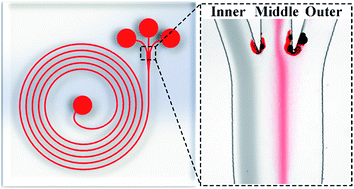Rapid separation of human breast cancer cells from blood using a simple spiral channel device†
Abstract
Circulating tumor cells (CTCs) are nomadic cells shed into peripheral blood from a primary tumor. As CTCs can be analyzed for early cancer detection and treatment monitoring, they play an important role in cancer diagnosis and therapy. Due to the extremely low number of CTCs in blood, separation has been regarded as an essential pretreatment step for the efficient detection of CTCs. In this work, we proposed a rapid and label-free method of separating human breast cancer cells from diluted blood using a spiral channel device. The effects of concentration and flow rate on blood cell focusing were investigated in order to optimize the operational parameters. Then, the separation of spiked MCF-7 cells was performed under a throughput of 400 μL min−1 and a blood dilution ratio of 100 fold. It was found that 99.04% of blood cells could be removed after a second stage separation. To further improve the separation performance, we separated the tumor cells from the lysed blood samples, and 87.98% of tumor cells were successfully recovered. With its advantageous features of a simple design, easy fabrication and low flow resistance, our device is expected to have great potential in biomedical and clinical applications.


 Please wait while we load your content...
Please wait while we load your content...